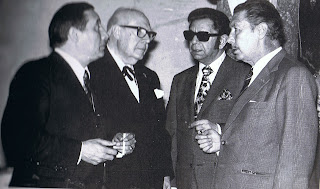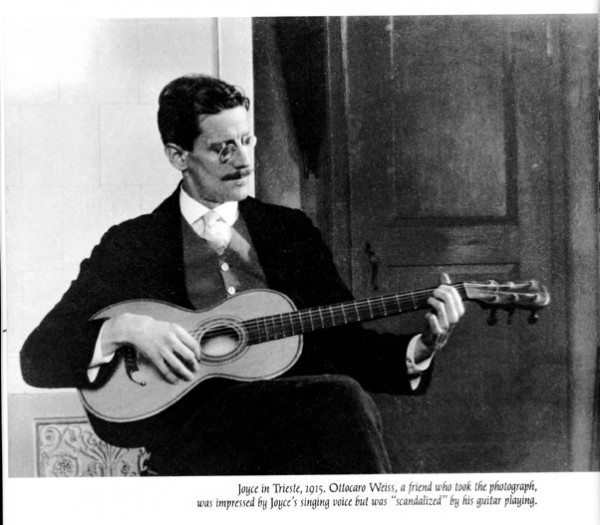Glenn Gould this time.
Bach, says Gould, was not so much ahead of his time as outside it. “For Bach, you see, was music’s greatest non-conformist, and one of the supreme examples of that independence of the artistic conscience that stands quite outside the collective historical process.” and
“Bach was the greatest architect of sound of all time”
Category Archives: Thoughts
Segovia and Flamenco
Segovia on Flamenco Guitar, Song and Dance – from Guitar Review, 1977
Segovia’s stated credo was that he, like the Blues Brothers, was on a mission from God — well, maybe not God, but a sort of holy mission — to rescue the guitar from the taverns and the associated lowlife folks in whose hands it was then found. Obviously, he could have problems with flamenco.
Well, not quite, as it turns out.

Manolo Cano, Andrés Segovia, Sabicas and Rafael Gómez Montero at the CONCURSO NACIONAL DE CANTE JONDO GRANADA 1922
Thanks to Brook Zern of the Flamenco Experience for this fascinating article.
Over-Practicing Makes Perfect | TIME.com
We don’t just need to learn a task in order to perform it well; we need to overlearn it. Sounds like a recipe for disaster? Depends on your approach. I have to constantly remind myself that practice is supposed to make performing a task easier, not more difficult!
Do read the whole article before jumping to conclusions!
Whenever we learn to make a new movement, we form and then update an internal model—a “sensorimotor map”—which our nervous system uses to predict our muscles’ motions and the resistance they will encounter. As that internal model is refined over time, we’re able to cut down on unnecessary movements and eliminate wasted energy.
More Airline stories and some positive recommendations!
Seems that many people responded (positively) to the post on JAL’s treatment of guitars on internal flights, so as a way of jumping on the luggage carousel, I thought that I would add some positive recommendations.

For me, the most stressful part of taking a guitar on a flight is the uncertainty that it will be allowed as cabin baggage or not, or that it will be well taken care of in transit in the hold, so here is a list of positive experiences I have had with ground staff and flight crew.
James Joyce’s guitar chord
Continuing my occasional foray into the guitar in literature, here is a famous picture of the author of “Ulysses” and “Finnegan’s Wake” presumably trying out a tune before a session (or maybe about to smash the guitar in frustration). In fact, Joyce was reputed to have had a fine tenor voice, and the singer John McCormack offered to teach him, encouraging him to take music as a career.
The original photo, taken by Ottocaro Weiss ,a friend who was “scandalized” by Joyce’s guitar playing, is housed in Cornell’s James Joyce collection, in an exhibit in a glass closet titled “Poetry and Music.”
Bach visualised
How often do we suspect that there is more going on in Bach’s music than meets the ear?
Well, a mathematical image-maker Jos Leys has managed to show visually how the first canon from Bach’s Musical Offering looks as it crawls its way first forward, then in reverse, then in both directions at once! Luckily we only have the odd fugue to contend with in the guitar/lute repertoire of Bach and we can play more than two strings simultaneously, unlike viola da gamba players.
Many thanks to Nigel Warburton for passing this on.
Poetry of the earth
Leonard Bernstein’s conclusion to his insightful lecture series, “The Unanswered Question” given at Harvard and televised in 1973.
Just to remind ourselves that Bernstein is more than “West Side Story”!
Frankenstein’s guitar, Shelley to van Halen
With news that scientists have succeeded in growing a mini brain in a Petri dish, Mary Shelley’s “creature” might well be on the way to being created in a lab.
Mary Shelley was an English novelist, short story writer, dramatist, essayist, biographer, and travel writer, best known for her Gothic novel Frankenstein: or, The Modern Prometheus (1818).
For our purposes, she was also married to the man who wrote a rather soppy poem about the guitar to Jane Williams with whom he was infatuated when his marriage was on the rocks.He was particularly taken by her musical gifts and skill as a housewife. Gadzooks! What a piece of male chauvinist lumber!
He was even too cheap to buy her what she really wanted, which was a harp from his friend Horace Smith in Paris, and when this proved too expensive gave her a guitar made in Pisa by Ferdinando Bottari around 1815. ‘I have contrived to get my musical coals at Newcastle itself’, he told Smith.

Apostolos Paraskevas Recovery from Focal Dystonia
My friend Apostolos Paraskevas has written two articles on recovery from Focal Dystonia.
He was very excited about his recovery and will be happy to share with anyone after the publication of the articles in Classical Guitar magazine.
There will be more about this most common and distressing syndrome amongst many professional guitarists.
Apostolos says:
I was struck almost overnight by focal dystonia (FD) to my right hand after a concert. Continue reading
David Russell’s Elegy for the victims of the Santiago train accident
Link to David Russell playing Celtic melody
“Estamos en duelo por el trágico accidente de tren en Santiago, la ciudad donde María Jesús y yo nos conocimos y que está tan cerca de nuestro corazón. Nuestro sentido homenaje a las víctimas y nuestro apoyo moral a las familias y a los supervivientes.”
“We are in mourning for the tragic train accident in our beloved Santiago (Spain), the city where María Jesús and I met. A Celtic melody in memory of the victims and our moral support to their families and the survivors.”
“My Gentle Harp” arranged by Gerald Garcia
Get the music here



